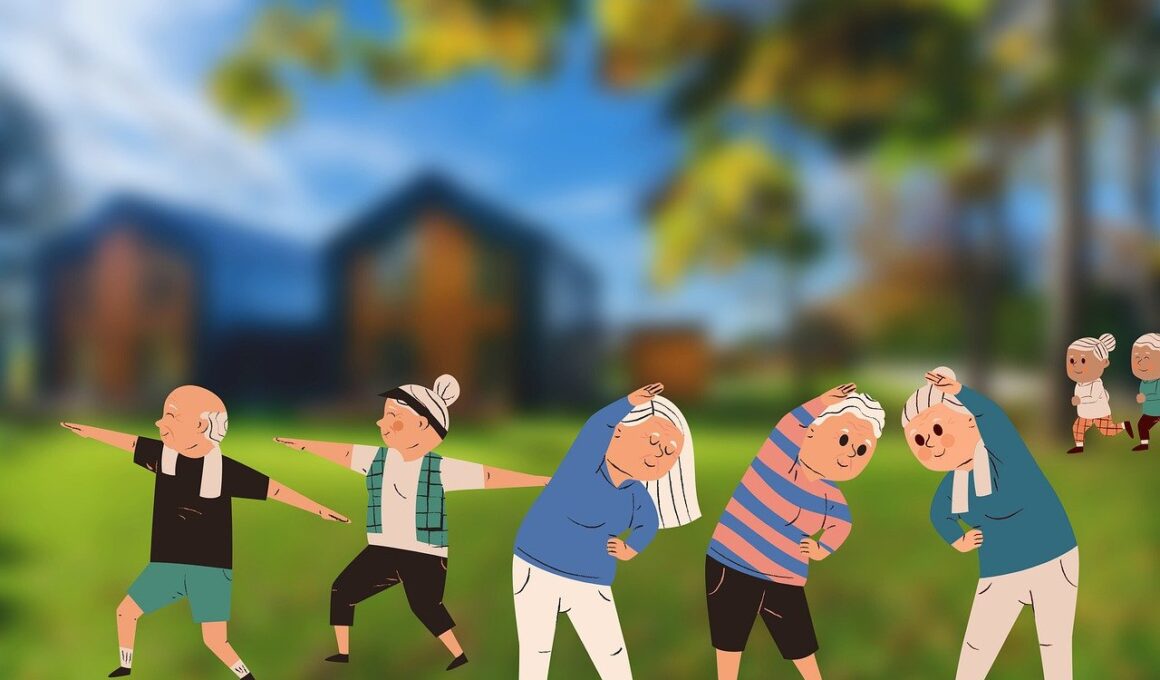Choosing the Right Group Fitness Class for Older Adults
As older adults increasingly prioritize health and wellness, group fitness classes provide an excellent avenue for staying active. It’s important to choose a class that aligns with your individual fitness level and health needs. This includes factors such as mobility, existing medical conditions, and physical capabilities. Facilitating social interaction, these classes can also help combat loneliness, motivating seniors to participate consistently. Additionally, group environments foster encouragement, essential for developing confidence in exercising. Before deciding on a class, it’s advisable to consult with a healthcare provider, especially if underlying health concerns exist. Moreover, most fitness centers offer introductory sessions allowing new members to test various classes before committing. Assess whether the instructor is knowledgeable about modifications for older adults since fitness instructors play a crucial role in ensuring safety and effectiveness in the workouts. Remember, a supportive atmosphere where everyone feels welcome can enhance your experience, making it easier to stick with a program. In summary, proper selection of group fitness classes can lead to increased physical health and overall well-being for older adults.
Different group fitness classes offer a range of benefits tailored to aging adults’ specific needs. For instance, classes like chair yoga focus on balance and flexibility without putting undue strain on joints. Similarly, aquatic fitness programs utilize water resistance for safer, low-impact workouts, ideal for maintaining muscle strength and improving endurance. Like resistance training, this helps combat muscle loss associated with aging. Moreover, walking groups not only promote cardiovascular health but also encourage social interaction, often leading to lasting community connections. Another option is dance-based classes, providing a fun way to improve coordination and rhythm while working out in a supportive environment. When selecting a class, consider the class size, schedule, and location. A smaller class size often allows for more individualized attention from the instructor, which can be vital for safety and effective learning. Further, being close to home can make it easier for seniors to commit to regular attendance. It’s crucial to explore various options, attending trials to find the class that resonates best with your interests and goals. Ultimately, the right group fitness class can make physical activity enjoyable and rewarding for older adults.
Benefits of Social Interaction
One significant advantage of participating in group fitness classes is the social aspect they provide. For many aging adults, maintaining social connections is vital for emotional and mental well-being. These classes create a sense of community, reducing feelings of isolation. Finding opportunities to engage in conversation and camaraderie enhances motivation, making it easier to stick with a regular exercise routine. Sharing experiences in a supportive environment can also lead to friendships that extend beyond the gym. Experienced instructors often encourage interaction among participants, fostering encouragement and building relationships. Creating bonds with peers can fight the challenges of aging, as new friendships may lead to additional outings and group activities outside of class. Furthermore, joining a group can help ease anxiety and apprehension associated with starting a new fitness regimen. By connecting with others who have similar fitness goals, seniors can feel more confident in their abilities. Active engagement during workouts improves mood and enhances the overall experience. In conclusion, the social benefits of group fitness classes for older adults extend far beyond exercise, providing opportunities for connection and enrichment.
As you consider joining a group fitness class, it’s pivotal to be aware of the available modifications and adaptations provided by instructors. Older adults may face unique challenges when it comes to physical activity, so having professionals who understand how to accommodate various abilities is crucial. Look for classes where instructors are certified in training seniors and can provide guidance based on each individual’s needs. This ensures that exercises can be performed safely while still being effective. Pay attention to how the instructor communicates clearly and adjusts the activities when necessary. Also, inquire about the class format—ensure there’s ample time for warm-up, cool down, and reasonable pacing during workouts. Having a strong emphasis on safety features promotes a worry-free workout environment for aging adults. Moreover, new participants should feel encouraged to ask questions regarding modifications for specific exercises, ensuring clarity on how to perform movements safely. Being open with the instructor can lead to personalized adjustments improving each participant’s experience. Lastly, as every individual’s fitness journey is unique, staying informed and engaged in discussions with instructors can enhance your overall fitness experience.
Setting Realistic Goals
Setting realistic fitness goals can help older adults attain measurable progress while participating in group fitness classes. It’s essential to remember that the journey of fitness is different for everyone, particularly for seniors who may be regaining strength or recovering from physical ailments. Start by identifying what you hope to achieve through class participation, whether it’s improving cardiovascular health, enhancing strength, or simply enjoying movement. Create SMART (Specific, Measurable, Achievable, Relevant, Time-bound) goals tailored to personal abilities. For instance, instead of saying, “I want to get stronger,” consider a goal, such as, “I aim to attend fitness classes three times weekly for the next month.” Track progress over time, celebrating small victories with fellow members to stay motivated. Additionally, flexibility in adjusting goals as you progress is key; if you find particular objectives too challenging, adjust them accordingly. Discussing these personal goals with your instructor can also help in finding specific exercises to support them. Ultimately, realistic goal-setting assists in maintaining motivation while fostering a positive relationship with fitness as older adults navigate their health journey.
In conclusion, the choice of group fitness classes for older adults can significantly influence their fitness journey. It is critical to consider personal health conditions, preferences, and goals when evaluating class options. The variety of classes available caters to a range of abilities, ensuring there’s something for everyone. Engaging in social interactions and forming connections can enhance motivation, support adherence, and bolster overall mental health. Instructors who are experienced in working with aging populations play a crucial role in ensuring exercises remain safe, effective, and adapted to individual needs. Additionally, flexibility in setting realistic goals can help create a sustainable and enjoyable fitness routine. Taking the time to explore options and commit to a suitable class can yield numerous physical and psychological benefits. As adherents develop new habits and incorporate movement into their lives, they may notice improvements in energy levels, mobility, and overall well-being. Embracing group fitness can create a positive ripple effect in the lives of older adults, paving the way for healthier, happier lifestyles. Now is the time to take that step toward revitalizing your routine and exploring group fitness opportunities.
As you delve into group fitness classes, remember to enjoy the journey and celebrate progress at every stage. Understanding your body’s needs and limitations while engaging harmoniously with others can create unforgettable experiences. Join a supportive community that empowers you to achieve your health objectives, embracing the joys of movement and physical activity. Group fitness isn’t just about exercise; it’s about enriching your life through engagement and connection. Be open to trying multiple classes to find the right fit and ensure you have fun throughout the process. Consider keeping a fitness journal to record your thoughts, experiences, and accomplishments, no matter how small. Reflecting on your journey can provide valuable insights into your preferences and changes over time, ultimately empowering you to continue pushing forward. Keep an adventurous spirit as you navigate this exciting chapter of your life. Engage with trainers, seek advice, and share experiences with fellow participants. Remember that fitness class options are abundant, and the right class can change your perspective on movement as well. Explore, stay active, and relish in the community that fitness classes can provide for older adults.


